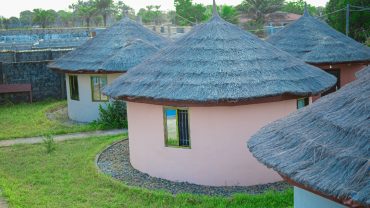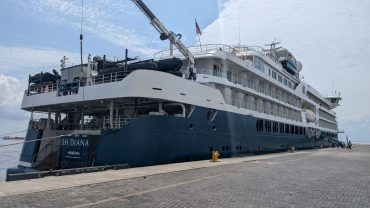Coming face to face with the enchanting relics of the mastery architectural display that once defined the merciless economical “glory” of the Bunce Island, you’ll know thereon, that this is a place that warrants the visitation of everyone, at least once in our lifetime. If not for the purpose of reflections, empathy, and a sense of history, but for the serene-celestial-leisure and the liberating experiences enveloped in both the boat journey and the tour of the strategic slavery fortress built in the bosom of Themne lands.
THE JOURNEY
The journey to Bunce Island is an entire adventure on its own. You get to have the chance to meet Freetown and the hinterland from the coastline. Our journey began at Aberdeen. About 15 of us including the tour guide and the boat operators boarded the white-coloured and roofed Mohamad Murtala, the boat set-out for the trip. The two engines fitted on the boat with a combined output of 400 horsepower was turned on and-off-we-go… In no time, Mohamed Murtala was splitting the waters as if it were a rocket shooting for the moon. The two engines were humming loudly leaving dozens of frosted waters in our wake.
Bunce Island is infamous for the central role it played throughout the transatlantic slave trade since its slave fortress was built in 1670. It is one of the 40 slave fortresses built on the coastlines of West Africa. Hundreds of thousands of black men, women, and children were directly carted from that Island to the Americas and Europe. Our boat faced away from the Atlantic Ocean. We were heading up rivers, where Bunce Island is said to be housed in the estuary of the Rokel River and Port Loko Creek which is about 20 miles off the coastal harbour of Freetown. The time it will take to go to Bunce Island varies depending on the place and means of transportation. For us, the journey will last for 45 minutes or even less.
Crisp winds barged into the boat through its windows as we continue to speed ahead. Freetown was more than a thousand meters ashore at that moment. From the east to the west, we could clearly see how the mountains sprawled like a huge junk of beautifully braided hairs. On the other side to our left, was Lungi. The land was flat as far as the eyes could see. We were in between two shores that offered us a stretching corridor of alluring landscapes, structures, vegetation, mangroves and breathtaking mini-cliffs. Almost everyone was mapping the journey with their professional cameras and phones. At that moment the thought hit me, no matter how many pictures we take, we would never be able to convey the serene-celestial-leisure we will savor from this boat ride.
We approached Bunce island from the North. Remnants from the heavily fortified border-walls of the fortress were visible from over 100 meters away. 200 years back, two or three shots would’ve been fired at us to determine whether we are an enemy or a friend. The northern bastion uses to hold up to 16 cannon guns, the tour guide said. Standing atop that area of the fort, we could clearly spot anyone, from miles away, that is coming from the Atlantic-wide. Within its ways, abandoned rows of cannon guns with King George’s insignia were half-buried in the ground. Each space that harbour a cannon gun, a gap about half a yard can be found. You need no lecture to understand that it was meant to give a clear shot and as well protect the fort forces as they battle enemy’s attack.
Mohamed Murtala anchored to a jetty recently constructed on the Island. The wooden floors with tires chained round it were floating steadily on the waters. The rest of the jetty was firm, having these iron-rocks design pillars that look timeless. Resounding air from the shallow beach and the hips of jungle that had settled on the island filled our lungs as we entered its shores. At the foot of the Island, we took about 5 to 10 minutes rest.
THE TOUR
So now, the tour begins… with Francis who is the tour guide for the trip. We scouted the well that was outside the fort. It about 2 to 3 meters deep. The water oozing from it was drank only by the Africans in and outside the fort. It said to be as old as the fort or even older. Francis leads us to the main entrance of the fortress. Relics of the door that used to be “the door of no return” still stands gallantly. It is about 2 feet wide and 8 feet tall. It is attached to the only remaining standing fence guarding the fortress. The fence was around 12/15 feet tall and a yard thick. It ran from the extreme north, onto the south of the Island. The rusty-coloured bricks blocks used in the construction of the fence and the entire structures in the fort were shipped directly from England the tour guide revealed. Oyster shells were used as cement to hold the walls together. It was heated with lime until it melted, ready to be used. As we were entering the compound of the fortress, our body movements went solemn, it became apparent that the pain our ancestors felt while they were being led out, through the door of no return was brewing emotional distress in our souls.
When we entered the yard of the fortress, our first stop was the northern bastion. It was where the defense mechanism of the fortress was stationed. It housed mainly the cannon guns and a very defensive wall. The administrative building was few yards away from the northern bastion. It was built on the north-eastern side of the island, perhaps the center of the fort. Most of its structure was buried underground with a formidable tower separating the administrative building from the kitchen house. Only a few walls and the structure’s foundations remain for most of the buildings in the fort. The courtyard spanning the length of the fence used to be the playground for the whites. The tour guide said it used to have a patio and a golf course. On the South-end of the fence, they have the powder store. It where the powder used to operate the guns were kept. It was strategically built away from the main structures so, in case of explosions, the main structures will be unaffected. Underneath the powder store, an underground cold room was built. Ice from Europe was stored underneath and it could hold for days. Whiskey, rums and other goods they get from batter-trading where also stored in that building. It is worthy to note that the fortress has been rebuilt and redesigned several times.
The moment where we couldn’t control our emotions arrived. We were standing on the doorway that leads to where the captives were stored. It has large concrete-like walls all over it and space about 2 feet wide serve as the door. Within that door, there are two more doors. One leads to where the male captives are stored, the other leads to where the female and child captives are stored. 200 years back, we would have entered the first door and it would be closed on us. And then, either the male or female and child door would have been opened for us, depending on our biology and physicality.
Our rights as human beings would have been non-existent. The thought of that was eating our peace alive. All of us were showing remorse. The tour guide leads us through the female and child section first. It is an open field about 70 meters in size. It has never had a roof throughout its existence. The captives were at the mercies of the sun and rain– the floor is just the bare ground. Now imagine what their day and nights were like… They were treated like how we treat our goods in warehouses, even our goods these days are accorded some amount of dignity. On a daily basis, the females were raped, by the white masters. The tour guide relates.
When we entered the male section, the condition was the same. Perhaps the males receive more beatings than the female and child. Sympathy, remorse and discrete mumbling were flying out through sighs at that moments. You could tell, we were literally cursing everyone who had a hand in the functions of this place. The male section is about two times the size of the female and child section. The fortress is said to hold about 800 or more slaves at a time. On the South-south side of the fortress, where the slaves were stored, theirs is an escape route that leads to a boat that was always on standby- ready to transport the goods (slaves) to the mainland on the south in case the fortress is attacked. The slave fortress at Bunce Island was so significant to the British that it was attacked and burnt down anytime the British had a conflict with another sovereign authority or anytime the slavery business receives a strong western resistance.
We took about 35 to 50 minutes to scale the entire fortress. Our next stop was the last settlement built on the west of the island for the Africans that were working in the fortress. It was about 200 or more meters away from the fortress. Barely any relics remains of the structures that were there. The village was closed to the graveyard on the island. Based on the layout of the cemetery, you could tell that the whites must have hated the blacks so much that even in death, they separated themselves from the blacks. The whites were buried at the south-west of the island completely separated from the blacks who were buried on the north-west of the Island. All the whites buried there had tombstones. One tombstone dating back to the 1767s was still intact. Only one black man had a tombstone attached to his grave. He was called Bai Adams and he used to be a chief. The rest of the black graves were unmarked.
The tour had come to an end. We gathered ourselves back at the foot of the Island. While we were having a light refreshment, we took time to recounts the experiences we have had on the tour. Even though we all came from diverse backgrounds and nationalities, we all agree that the excursion is a worthwhile adventure. It spurs us to reflect on the past, confront our bloodied history and empathized with the thousands who were robbed off their homes, loved ones, peace and dignity.
Check out the following page for dates for Bunce Island trips in December and January.
Bunce Island Excursions 2019
- Blog
Introducing Chikadi Huts Resort – Lungi
Chikadi Huts Resort is a small resort in Thorlmosoh, Lungi, about 15 min drive from Targrin, and 10 min from the airport. CHIKADI huts resort offers 15 one-bedroom chalets in a cozy natural african village setting and in a serene and eco-friendly atmosphere. This is a Q&A with the owners of the Resort. 1. What […]
- Blog
Q&A with Malaika Cheney-Coker regarding her debut novel – Creature of Air and Still Water
Malaika Cheney-Coker was born in Nigeria and spent her early years there, as well as some time in the Philippines with her maternal relatives. She later moved to Sierra Leone, where she spent the rest of her childhood. In this Q&A, we discuss her Sierra Leonean roots, the themes explored in her book, and her […]
- Blog
In commemoration of our Independence Anniversary on 27th and 28th April, we were delighted to welcome over 350 excited expedition passengers aboard two luxury cruise liners, SH Diana and Silver Wind, in Freetown. These magnificent vessels docked at Elizabeth Quay and off the Aberdeen Coast, respectively, earning Sierra Leone a prominent place on the global […]




Comment (0)